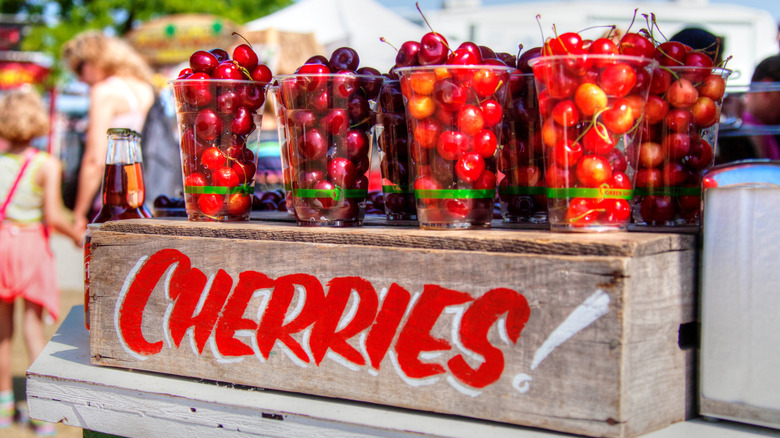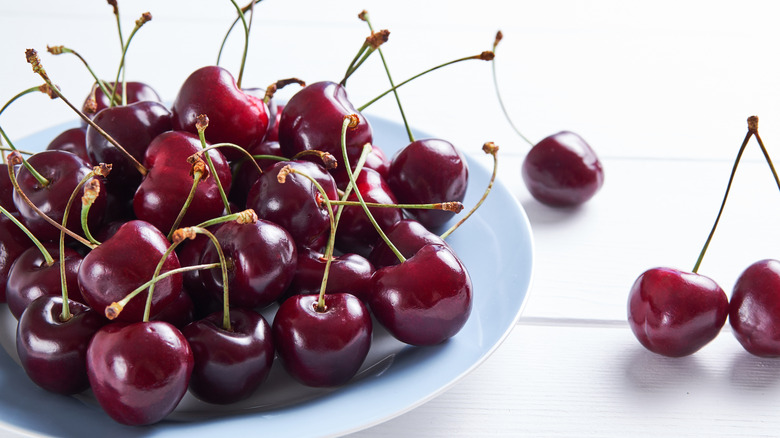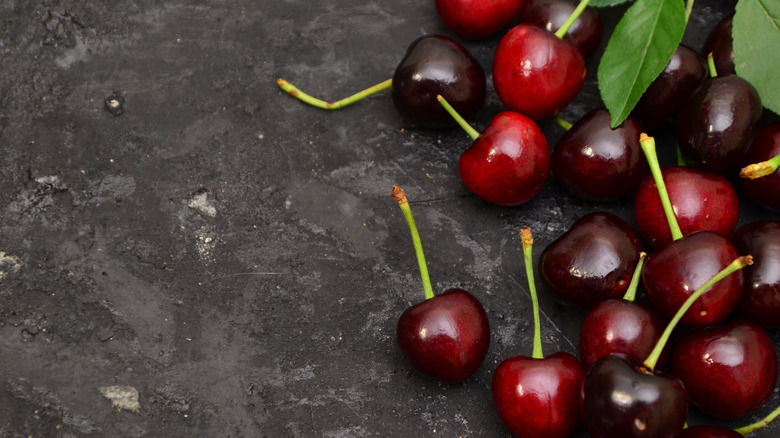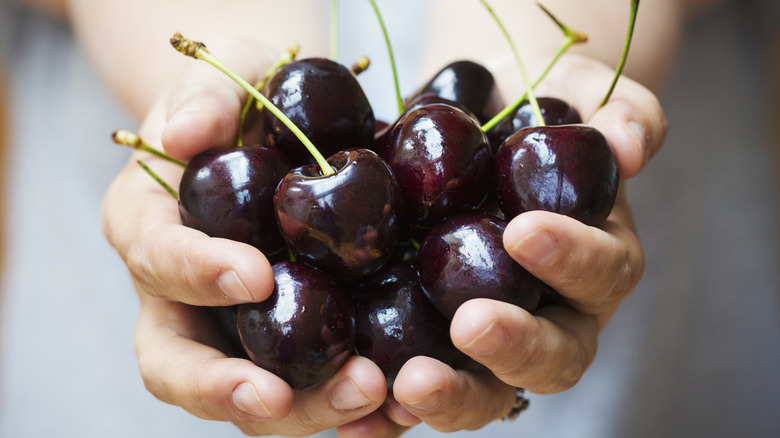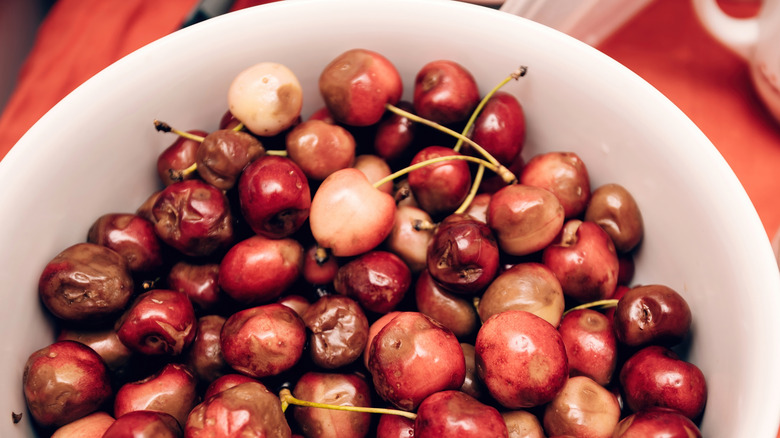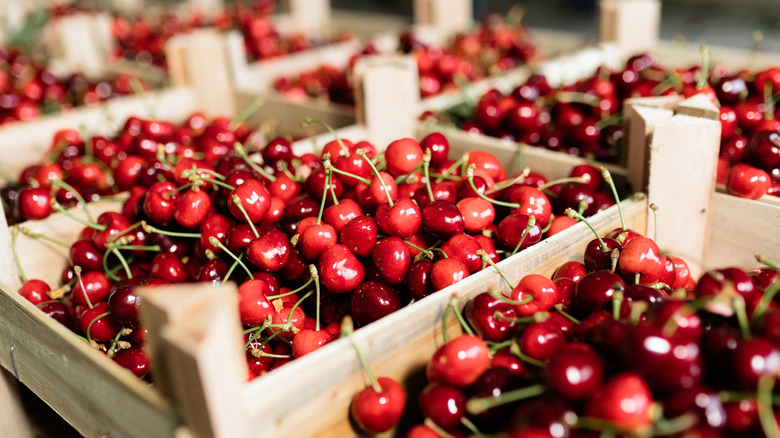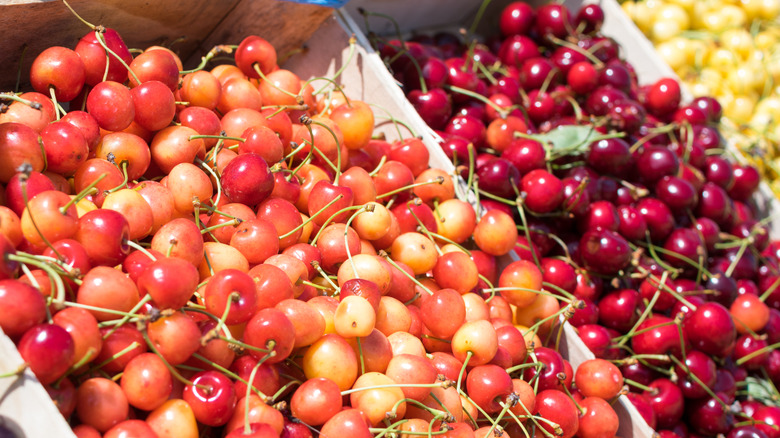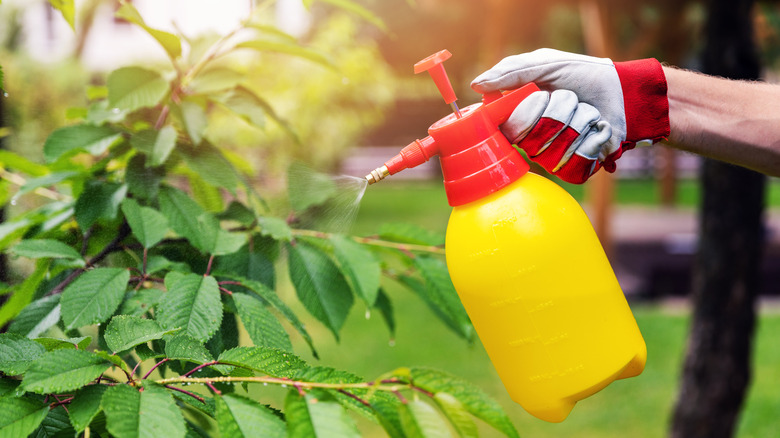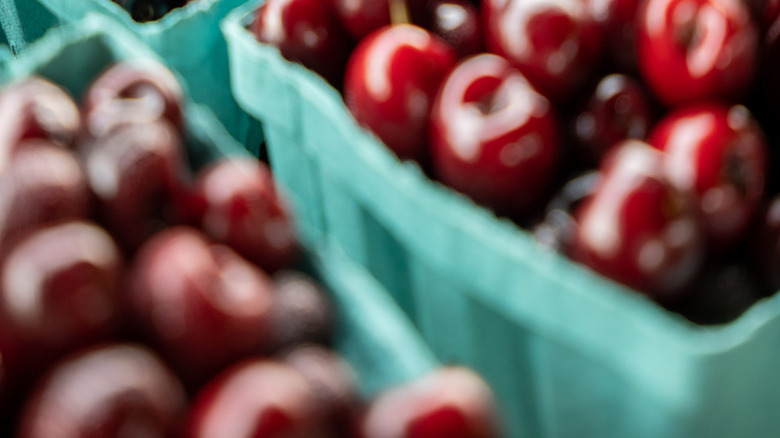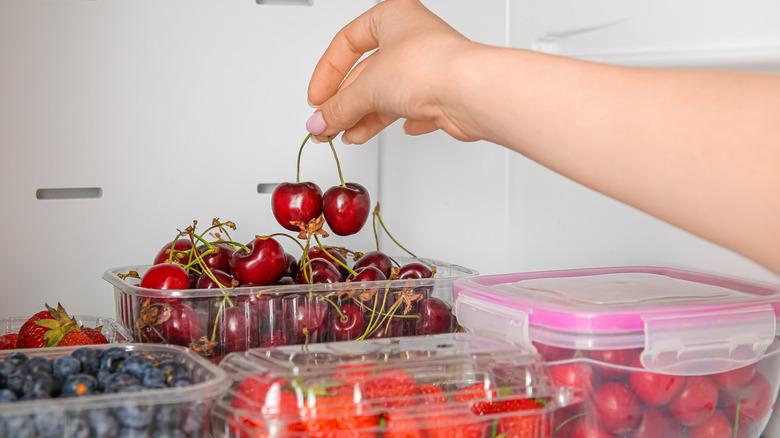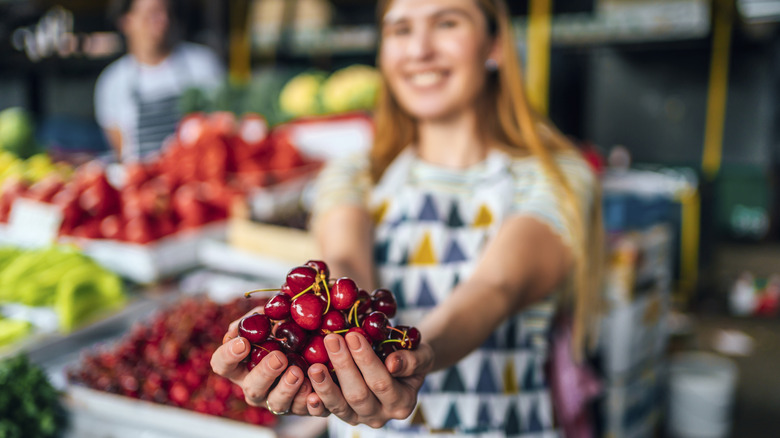Mistakes Everyone Makes When Buying Cherries
If there's anyone who knows the ins and outs of cherries — what makes them delicious, when to eat them, and which varieties are your best bet — it's Frank Levering, the owner of Levering Orchard in Virginia. Now, in its 117th year, this family-run orchard was recently named one of the "15 Best Cherry Orchards in America" by Tasting Table, and for all the best reasons.
With 4,000 cherry trees spread across 33 acres and a jaw-dropping 59 varieties to choose from, Levering Orchard is heaven for a cherry lover. And Levering, who carries on the legacy of his grandparents and parents, also happens to be a best-selling author and playwright. He generously shared his expert input about the most common mistakes people make when buying cherries. From choosing the wrong type at the grocery store to learning how to eyeball and pick out the best, Levering's on-the-nose advice will change the way you shop for cherries. So, before you reach for that glossy-looking punnet from the supermarket shelf, make sure your summer fruit game is leveled up and primed for the pick of the bunch.
Not choosing cherries with stems attached
Those picture-perfect cherries you see in cartoons or magazines — you know the ones — shiny, red, and dangling off bright green stems? Yes, those. Well, turns out they really are the ideal cherries to look for when shopping for this summer bounty. Our expert agrees, as well. "Experience does suggest that cherries with stems keep somewhat longer than those without," explained Frank Levering. "Cherries are fragile and, once picked, very perishable. If the 'armor' of their skin is punctured in any way, as can often happen when picked without stems, they become even more perishable, and generally don't keep as long, especially when very ripe."
In fact, you should store them that way too, and only remove the stems just before eating. A bright green stem is a clear sign of freshness, and keeping it in place helps the fruit stay fresh for longer. It's a simple trick to enjoy the best cherries whenever you like.
Not checking the color
What about the color, you ask? Are dark red cherries your only choice? Well, yes and no. A deep, dark color usually indicates ripeness, but it's a fine line. Too dark, and the fruit might be overripe. "Generally, optimal ripeness equates with darker, richer color," Frank Levering told us. "It's tricky, though, because there's a lot of color variation among varieties. I think it's smart to ask the seller what variety the cherry is, and over time, with tasting experience, learn what color with that variety equates with optimal ripeness. Generally, though, lighter color indicates the cherry isn't fully ripe. But not always. Hence, learn the variety you're buying."
Some varieties, like Rainier, run the gamut of shades from pale pink to golden yellow. Bing cherries, for instance, should be a rich mahogany red that's almost black. Essentially, ripe, ready-to-eat cherries should have a vibrant hue and deep saturation of whatever color they are meant to be. The deeper the shade, the sweeter the fruit. Shiny skin is another good indicator of ripeness, and along with color is one of the easiest ways to spot the perfect bunch at a supermarket or grocery store without having to inspect them up close.
Don't forget to check for firmness
Apart from color, don't forget to pay heed to the delicious plumpness of a perfectly ripe cherry. These little ruby orbs should be almost bursting with firm skin and smooth, plump bodies. "With close inspection — lean down close to the cherries and eyeball them — to some extent you can 'read' a cherry's firmness without touching it," advised Frank Levering.
Once again, it's key to know the variety. "Cherry cultivars are bred for much variation in natural firmness, explained Levering. "Also, firmness can be false gold — at times, it indicates a cherry was picked green and isn't fully ripe. This happens a lot with stone fruits in general, especially at West Coast orchards that ship fruit long distances and know that ripe fruit will "go down" faster. Another reason to buy local, if you can."
As cherries continue to ripen and spoil, they will become softer and start to lose their color. Cherries should be firm and plump, walking that delicate line between underripe and hard, and overripe and deflated. The timeline between these two stages is surprisingly small, so if you do have the opportunity to rootle around and give some cherries a gentle squish, please go ahead before you part with your hard-earned money. In case you can't, remember there are always hacks for overripe fruit to prevent food wastage.
Not leaving out the blemished ones
When it comes to choosing cherries that will deliver on their promise, you need to be ruthless. Out go the ones with visible bruises and dark spots. Needless to say, soggy, soft ones or those with mold should not even gather a passing glance. By now, you must know that these fruits are past their prime and nothing can save the day. If the cherries have cuts or are leaky, you know what to do.
But don't worry about smaller imperfections. "Minor blemishes, in my experience, are harmless, whether for cooking or simply eating," explained Frank Levering. "In some cases, they may even indicate that less spraying has been done. Wrinkling can suggest a number of things, but in cherries, generally it usually suggests overripeness."
If you are buying loose cherries, sorting out the wheat from the chaff is much easier than it is when picking up a punnet. The tricky thing with pre-packed cherries is that the presence of even one or two old, moldy specimens has the power to ruin all the other cherries that touch them. Best hack? Get home and sort through the punnet right away to remove any offending pieces and protect the virtue of the rest of your bunch (and stop yourself from eating a moldy one by mistake).
Not buying when in season
When you buy fruit at the right time, it's usually at its best in terms of freshness, taste, looks, and value. The caveat? Cherries have a very short season. Depending on the location, cherry season typically runs through late spring and summer. So you are looking at the best produce to hit the stores between May to August, with July being peak cherry perfection.
"Here's a mantra for buying cherries: Whenever possible, buy them right after they are picked," Frank Levering advised. "Cherries never taste better than when they've just come straight from the tree. Chilling them, shipping them for days across the country, shipping them in the winter from New Zealand — all far from ideal." And any claims of 'freshness' may also be false, he warned. "They are decidedly not fresh when you buy them after they've been shipped. The flavor may be okay. But thousands of customers have told me they've never tasted a cherry as good as the ones they get at our orchard straight from the tree on the same day it was picked."
Now we are not saying don't buy cherries out of season (well, we kinda are), but just know that you shouldn't expect the same looks, quality, or price point as when they are at their best. Levering's advice is simple: "If you live in a region where cherries are grown — go straight to a cherry orchard if you want great cherries!"
Not knowing the different types available
Let's talk types. Cherries come in two main camps: sweet and tart. Before you pick a bunch, it's worth knowing which kind you're dealing with. First up, you have sweet cherries. Round, red, juicy, and full of sugar, these are the fruits you want to pop into your mouth right away. Then there are the Bing and Rainier cherries. Bings are the classic, so dark they are nearly black, while Rainiers are pale in color, they bruise easily, and are usually more expensive because of the shorter harvest window.
Tart cherries usually don't make it to grocery stores as they spoil easily in transit, but they can be found at farmers markets or even in your frozen food aisle. "Generally — not always — tart cherries are shinier, glossier than sweet cherries, and lighter-colored," said Frank Levering. "But again, know the variety, as some tart cherries, like the Northstar variety, are very dark."
If there is no label on your cherries, "ask the vendor," advised Levering. "And if they don't know the variety, they need to know it. This is another reason to buy at an orchard. Folks there grew that variety and can tell you what it is." Bottom line: Choose your cherry based on what you're using it for. Sweet cherries for snacking, tart cherries for baking, and if you're lucky enough to find both? Buy now, and thank yourself later.
You don't always have to choose organic
What about buying organic? While organic implies a lower exposure to pesticides and chemicals, and in many cases may also mean slightly higher nutrient levels and better farming practices, this type of produce also tends to be more expensive.
If you have access to organic cherries (and can afford them), we say, go ahead and splurge. Especially when it's peak season and the fruit is likely to be the freshest and most delicious. "Cherries can retain pesticides, so if that's an issue, the higher price of organic cherries is likely worth it," explained Frank Levering. "If the cherries have been sprayed conventionally with pesticides, as they almost always are on the East Coast and in the Midwest, ask how many times they have been sprayed, and with what pesticides. There are ways to reduce the number of sprays, as we do — and reducing sprays, if possible, is a good thing for consumers."
However, if your local market or store only carries regular cherries, or if organic does not fit in your budget for now, there is no need to stress. That's no reason to skip this short-season, nutrient-packed fruit entirely. Just be sure to give your cherries a good rinse before eating, and store them properly to avoid early spoilage. A quick soak in a mix of cold water and baking soda or vinegar can help remove surface residues and make them safer to consume.
Not checking the packaging
Come summer, it's the time for farmers markets and buying fresh, delicious produce. However, when you buy cherries, it's important to check how they've been packed and stored before you buy. "Selling cherries in pint or quart containers is an old trick — you can be fooled into thinking you're getting a good amount of cherries for the price," warned Frank Levering. "Customer-friendly cherries are most likely to be sold by the pound. But beware. Do you really want to pay $14.99 a pound for New Zealand cherries, as I saw last January in Los Angeles?"
If the cherries come in crates, check to make sure the wood is dry. Sometimes vendors will spray fruit with water to keep it looking fresh and appealing. This not only adds to the overall weight (hello, higher price tag), it can also lead to faster spoilage. If you suspect that's the case, ask to have the cherries weighed separately before transferring them to a bag. Definitely, a red flag to look out for. Plastic packaging wrapped in cling film isn't much better. It traps moisture, encourages mold, and can turn your perfectly good cherries into a soggy mess before you even get home.
Don't be shy when buying at farmers' markets. If something feels off, trust your instincts. Whether it's a wet, heavy box or clingfilm that's fogging up, you have the right to ask questions or request a closer look. Remember, you are protecting your future snacks.
Not storing them properly
You've scored the juiciest, darkest, unblemished firm-yet-juicy cherries, and you're heading home to enjoy the bounty. Well, unless you plan to finish off the lot in one fell swoop (and we all know what happens when you do that — they can have a laxative effect), there are a few things you can do to ensure you have cherries at your fingertips for longer and avoid wasting the summer fruit.
Sort out the cherries (remember — toss the dodgy ones), but do not pick them off the stems. Also, surprise, surprise, do not wash cherries if you don't plan to eat them ASAP. Water causes sogginess and speeds up spoilage. Store them dry and stemmed in a container in the fridge for optimum freshness.
"To store cherries and make them last, refrigerating them is your best option," advised Frank Levering. "Cherries don't ripen after you pick them, but they do, especially when they're really ripe and it's hot, begin to deteriorate in quality. You can also freeze cherries, which suspends deterioration for many months. I've often frozen cherries in June, after picking them, then eaten them as they are, or in a pie, at Christmas and New Year's." Properly stored, cherries keep for about four to 10 days. If your cherries are out at room temperature (especially in summer), plan to use or eat them the same day, or toss overripe stone fruit into a sauce.
Not freezing them to last longer
So, you've stored your cherries optimally and you're dreaming of enjoying this summer sweetness long after the season ends. Well, the good news is that it is possible to freeze them with the right precautions. Start with firm, ripe fruit (the sweeter, the better), and sort through small batches at a time to minimize contact. Remove the stems, and rinse the cherries and dry them thoroughly. You will need bone-dry fruit in order to prevent mold and rot during the storage period.
Now, take a baking sheet and place the cherries in a single layer. Do not overcrowd the sheet or pile cherries atop each other. Pop this tray into the freezer for a couple of hours until the cherries are firm and cold. You need this to prevent them from freezing together in one big, unwieldy clump.
Once frozen, transfer the cherries into freezer-safe containers or plastic bags. As always, squeeze out as much air as possible before sealing them tightly. Don't forget to label and date before freezing. When you're ready to give in to an unseasonal cherry craving, let the cherries thaw at room temperature or overnight in the fridge. And one last word of advice: If you didn't already pit the fruit, proceed with caution — the last thing you need is to chip a tooth on a rock-hard, frozen cherry pit. Ideally, pit the cherries (try the chopstick hack) before freezing.
Where to score the best cherries
To sum it up, we asked our expert, Frank Levering, if he had any insider tips to score the best cherries. His advice was, as far as possible, to go to the source: "If you can't go to an orchard for that truly El Primo cherry, often a pretty good bet is a farmers' market where the grower or representative is selling cherries in season and straight from the cherry orchard," he advised. "I've tasted fabulous cherries at farmers markets in Portland, Oregon, Los Angeles, and New York City. And for about five Saturdays every year, I sell our just-picked cherries at the farmers market in Blacksburg, Virginia, right next to the Virginia Tech campus. It's the next best thing to eating cherries right there at the tree."
Levering is personally a fan of Black Gold sweet cherries, which you need to get from an orchard since you probably won't find them in stores. He also enjoys perfectly ripe, sweet Rainiers. "Knowledge of what's truly ripe, at full maturity, is hard to come by for folks who only buy cherries in stores," he explained. "So many new customers here have never tasted a fully ripe cherry before — and never realized that was the case!"
